
 HOME
HOME CONTACT
CONTACT SUPPORT
SUPPORT SENSORYTEST.COM
SENSORYTEST.COM |
 HOME HOME CONTACT CONTACT SUPPORT SUPPORT SENSORYTEST.COM SENSORYTEST.COM |
|
Sensory testing professional's favorite virtual desktop. Say hello to SIMS Cloud Systems. From any device, any laptop, any iPad and even your cell phone. Log in from anywhere anytime. Inquire today. 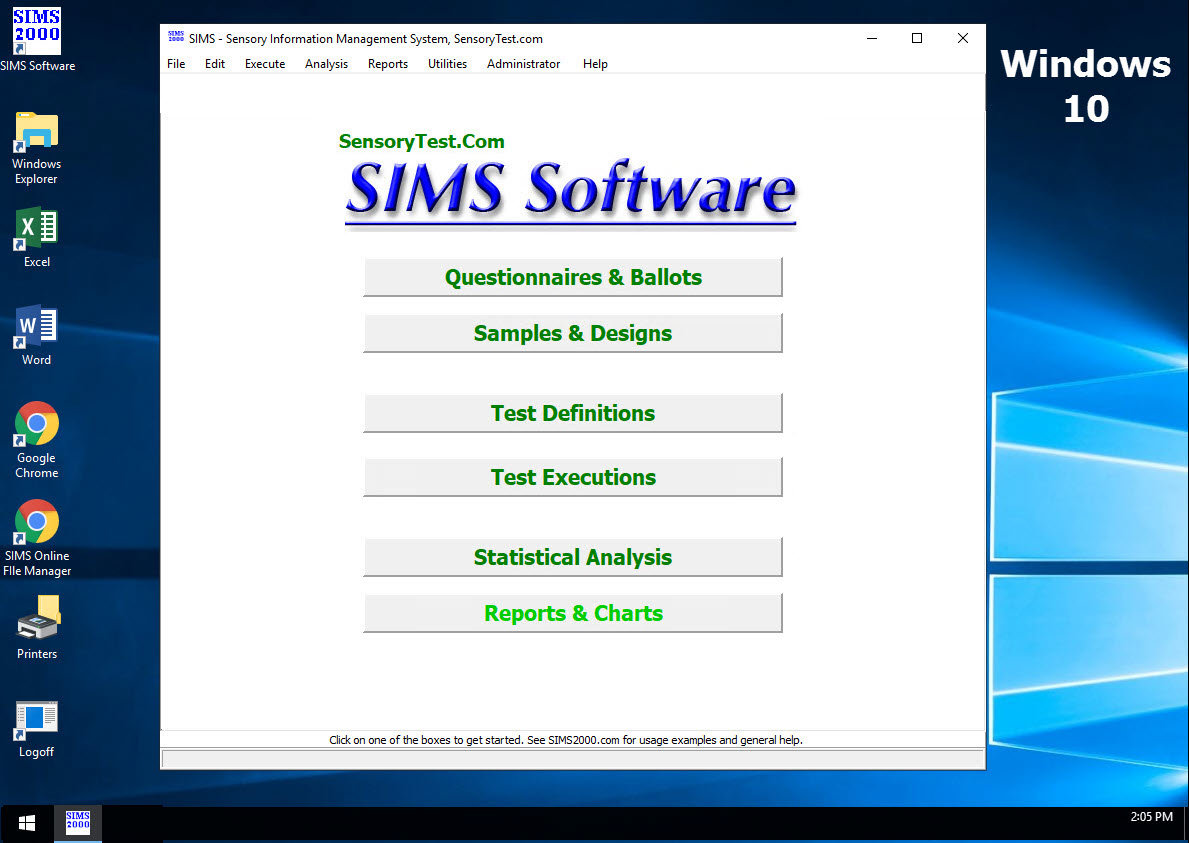
|
Mobile devices real test example Point your cell phone camera Easy for your respondents 
Link |
 VIEW REPORTS
VIEW REPORTS |
 QUESTION CHOICES
QUESTION CHOICES |
 TEST CHOICES
TEST CHOICES |
| Discrimination Duo-Trio Examples | View More Question Type Choices |
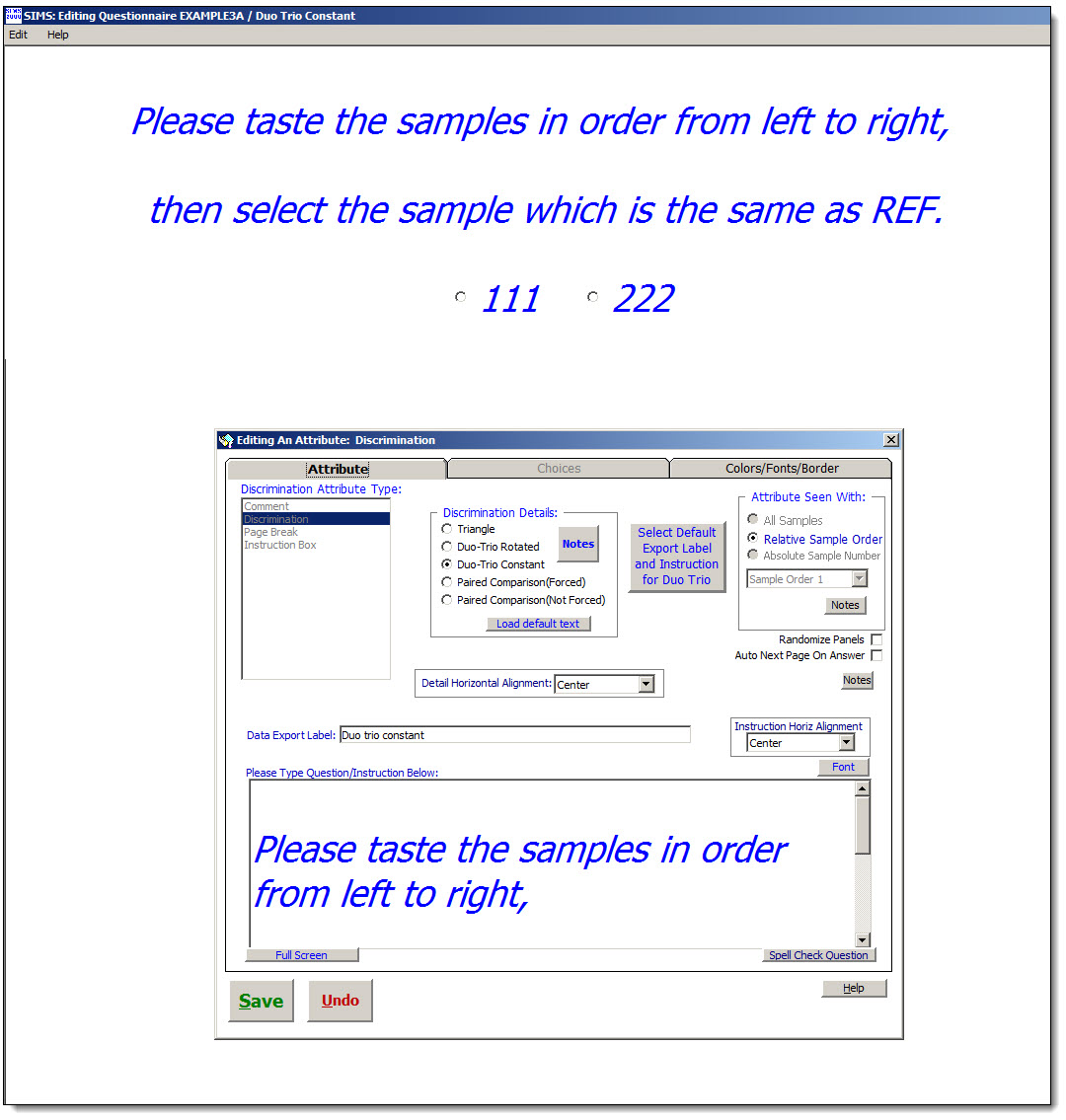
|
| Duo-Trio Discrimination - Correct/Incorrect SIMS Report 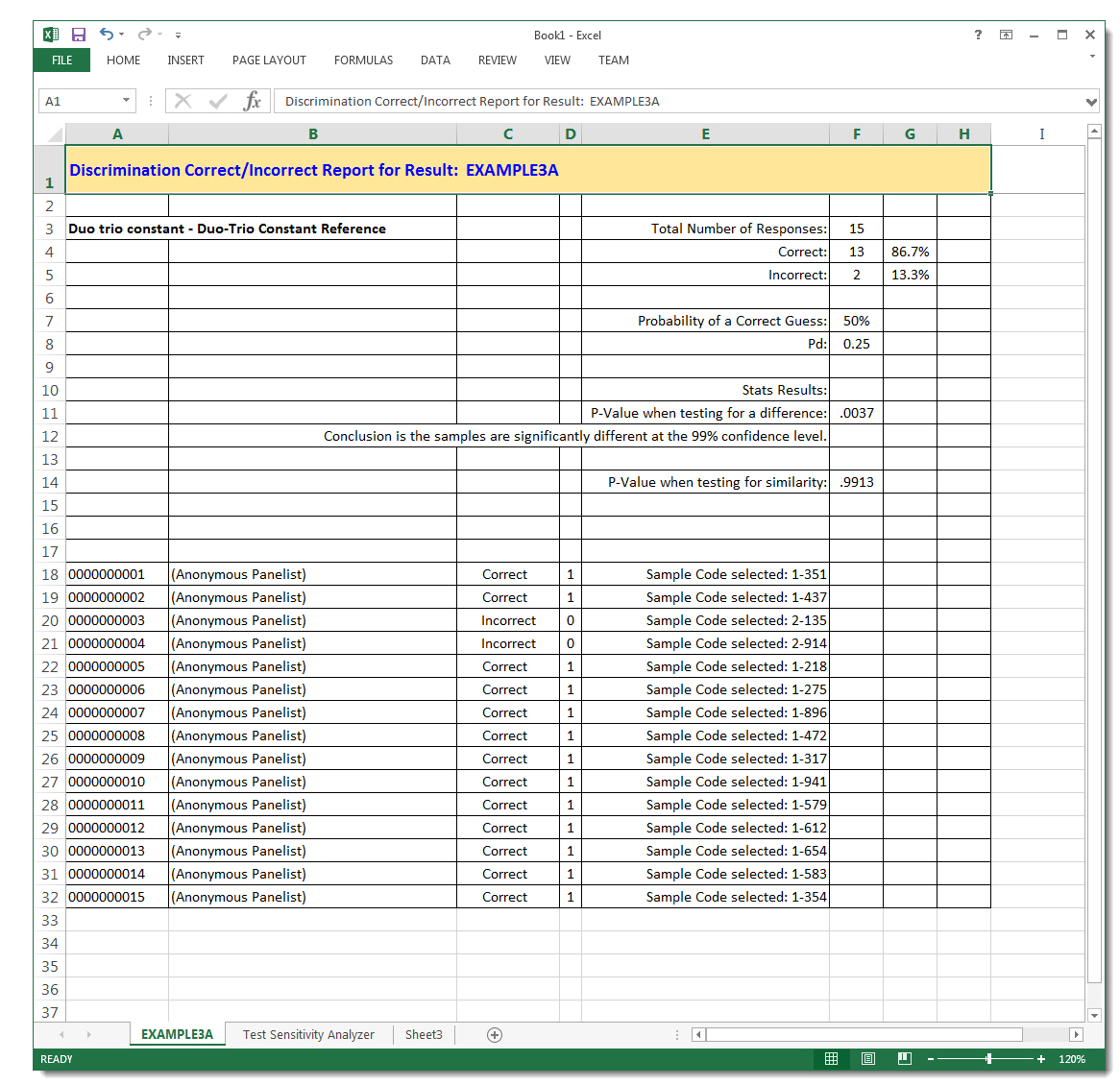
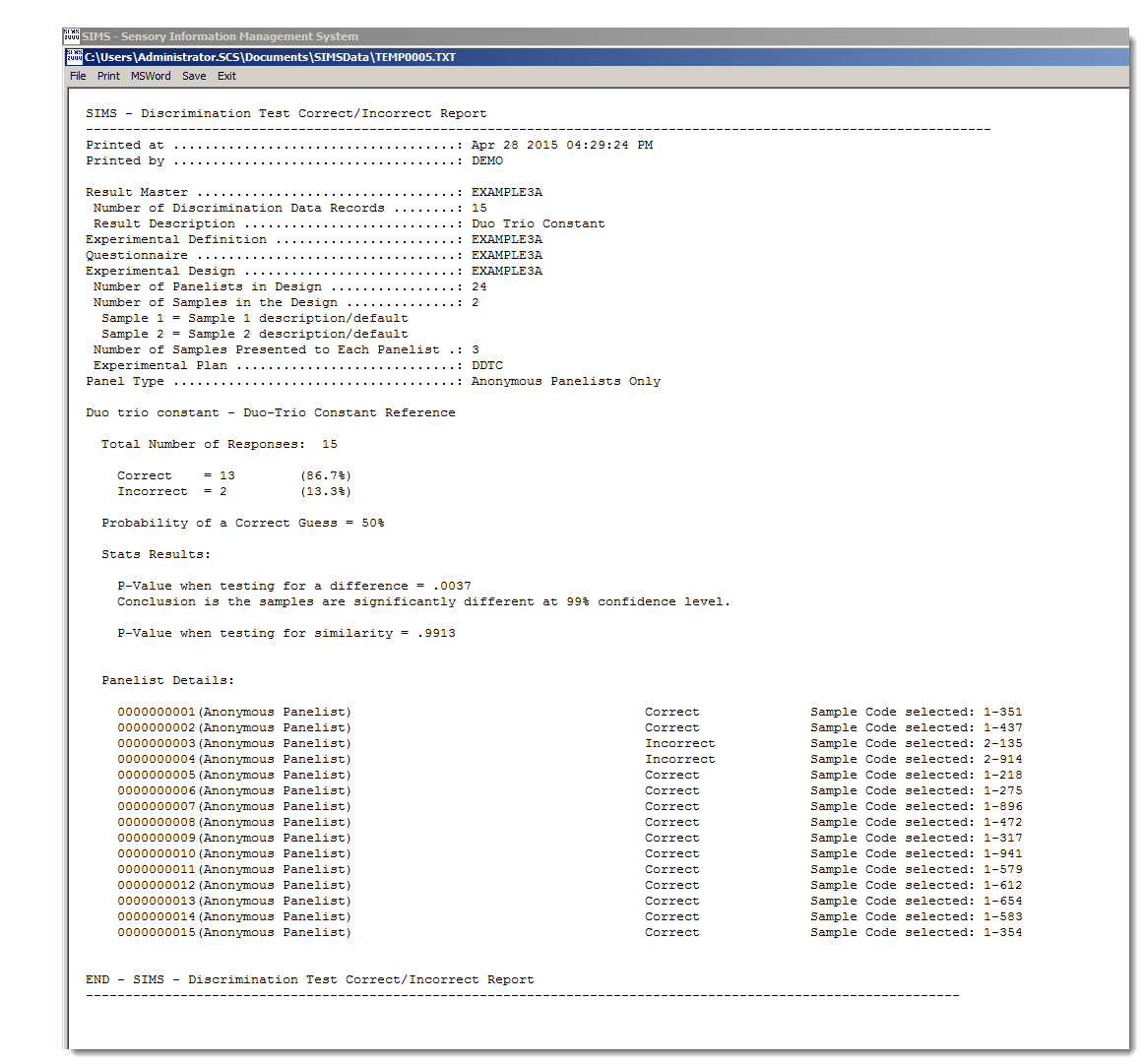
Report Setup 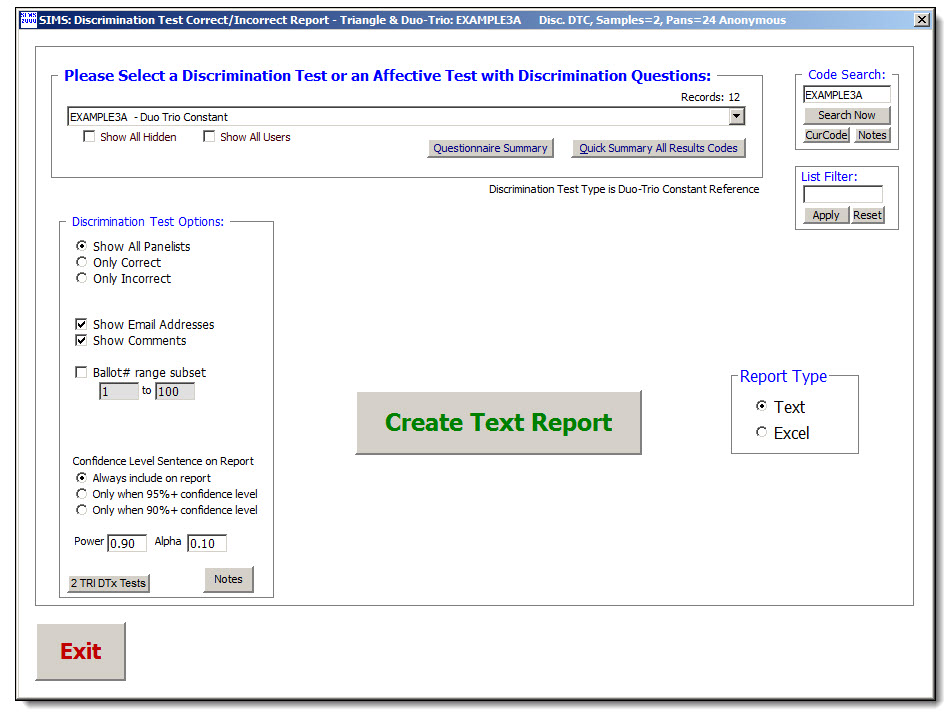
|
|
Example, Duo-Trio test with two reps, ADTR SIMS software express package file: ADTR-EX.SIMS2000ExpressPackage.sql.ZIP |
Duo-Trio (Rotated or Constant)
==============================
Panelist is presented with two coded samples and an identified reference sample.
One of the coded samples will be identical to the reference sample.
The panelist is asked to choose which of the two coded samples is different
from (or identical to) the reference sample.
There are two types of Duo-Trio sample presentations:
Rotated - the reference sample is ROTATED between the the two test samples.
Constant - the reference sample is always CONSTANT as the control sample.
Example: Please evaluate the samples in order from left to right,
then select the sample which is the same as REF.
Both DTR & DTC Questionnaire 'Seen With' Relative Sample Order 1. Two Choices ( ) 111 ( ) 222.
Designs are 2C3. Experimental Plans are DDTR (4 blocks 1 2 1 2 1 2 1 1 2 2 2 1) and DDTC (2 Blocks 1 2 1 1 1 2).
Result Data Values, the Value column for Discrimination Duo-Trio Tests: 1=Correct 0=Incorrect
Result Data Values, the Blinding Code column shows the actual Blinding Code selected by the panelist.
Result Data Values, the Sample column shows the Absolute Sample Number of the FIRST(LeftMost) Sample presented as defined in the Rotation Plan Sample Set for this panelist.
Paired Comparison
=================
Panelist is asked to compare two samples on the basis of some specifically
defined criterion. There are two types:
Forced - The panelist must select one of the two samples. (PC)
Not Forced - The panelist can select 'Neither' to mean both samples are the same. (PCN)
Optional: See Choices Tab to select custom text for No Preference.
Example: Please select the sample that is sweeter.
Result Data Response Values for Discrimination Tests (PCN, PCF), the Absolute Sample Number SELECTED by the panelist.
Most Reports in SIMS will report PCN PCF response data values as:
1 = Absolute Sample 1 selected 2 = Absolute Sample 2 selected . = No Preference
Such as Test Data Results Report, Test Raw Data Excel Exporting, etc.
For the editing raw test data area, and in the SQL database:
Paired Comparison Data value '1' means Panelist selected Absolute Sample 1
Paired Comparison Data value '0' means Panelist selected Absolute Sample 2
If PCN & No Preference selected, response value is Null '.'
Paired Comparison Reports:
- See Statistics areas, Discrimination Binomial Analysis.
- See Reports dropdown menu, Discrimination Reports, Paired Comparison Attribute Analysis.
- See Reports dropdown menu, Raw Data Exporting.
- And other reports.
2-AFC (Alternative Forced Choice) is also known as a Paired Comparison Test.
- Use this method to test for sensory differences between two samples, such as 'which sample is sweeter'.
- set up your 2-AFC as a Paired Comparison test, with PC or PCN, where an answer is forced or not forced.
- Same SIMS Paired Comparison Attribute Analysis, in addition to the other available reports.
- Reference #1: Sensory Evaluation Techniques, Civille, 3rd Ed.(pg 100), 2nd Ed.(pg 100).
Incomplete Block Paired Comparisons
Also commonly referred to as multiple paired comparison, multiple paired preference, pairwise ranking, and incomplete block paired preference.
Can not use the typical Discrimination PC since a 2 sample, complete block design is required.
Incomplete blocking such as 3C2, 4C2, 5C2, etc., when Samples >=3, and presenting only two samples.
Two alternative methods:
1) Ranking; Paired Comparison is similar to Pairwise Ranking.
Use an Affective type Questionnaire, SIMS Ranking Attribute question, 'rank all'.
2) Hedonic; using SIMS hedonic attribute type, 'select one'.
Set up the ballot as an Affective questionnaire using Hedonic Attributes instead of the typical two sample Discrimination PC.
Affective questionnaire will allow for more flexible Incomplete Block Experimental Design and Experimental Plan Rotations.
Create an Hedonic attribute type with two choices and label the choices them with the following special TAGs.
<RELATIVE_SAMPLE_1_BLINDING_CODE> select the choice return value to be = 1
<RELATIVE_SAMPLE_2_BLINDING_CODE> select the choice return value to be = 2
The above example will present two choices with the blinding codes for the two samples in randomized order perfectly matching the Rotation Plan in the Test Definition.
Example: Which Sample do you prefer OVERALL?
( ) 135 ( ) 246
Note: The 'Attribute Seen With:' option should be set to 'Relative Sample -- Last Sample', so that this question is only seen once at the end of the ballot.
Note: See Webpage: http://www.SIMS2000.com/Sample11.asp for additional and the latest information.
Positioning of Discrimination Attributes in Affective Questionnaires
====================================================================
There are several guideline rules to follow when including a Discrimination
Attribute in an Affective Questionnaire:
1. The Discrimination Attribute must be either 'Seen With Sample Order 1'
or 'Seen With Sample Order 2.' or 'Seen With Last Sample'.
2. If a Discrimination Attribute is Seen With Sample Order n, then
all discrimination attributes in the same questionnaire must also
be Seen With Sample Order n, where n = 1 or n = 2 or 'Seen With Last Sample'.
3. All attributes seen on the same page as a Discrimination Attribute
must be seen with same sample as the Discrimination Attribute.
4. You can include any attribute type except 'Time Intensity' on the
same page as a Discrimination Attribute.
